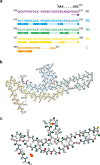This is a preprint.
Novel tau filament folds in individuals with MAPT mutations P301L and P301T
- PMID: 39185206
- PMCID: PMC11343192
- DOI: 10.1101/2024.08.15.608062
Novel tau filament folds in individuals with MAPT mutations P301L and P301T
Update in
-
Distinct tau filament folds in human MAPT mutants P301L and P301T.Nat Struct Mol Biol. 2025 Aug;32(8):1470-1478. doi: 10.1038/s41594-025-01575-9. Epub 2025 May 29. Nat Struct Mol Biol. 2025. PMID: 40442318 Free PMC article.
Abstract
Mutations in MAPT, the microtubule-associated protein tau gene, give rise to cases of frontotemporal dementia and parkinsonism linked to chromosome 17 (FTDP-17) with abundant filamentous tau inclusions in brain cells. Individuals with pathological MAPT variants exhibit behavioural changes, cognitive impairment and signs of parkinsonism. Missense mutations of residue P301, which are the most common MAPT mutations associated with FTDP-17, give rise to the assembly of mutant four-repeat tau into filamentous inclusions, in the absence of extracellular deposits. Here we report the cryo-EM structures of tau filaments from five individuals belonging to three unrelated families with mutation P301L and from one individual belonging to a family with mutation P301T. A novel three-lobed tau fold resembling the two-layered tau fold of Pick's disease was present in all cases with the P301L tau mutation. Two different tau folds were found in the case with mutation P301T, the less abundant of which was a variant of the three-lobed fold. The major P301T tau fold was V-shaped, with partial similarity to the four-layered tau folds of corticobasal degeneration and argyrophilic grain disease. These findings suggest that FTDP-17 with mutations in P301 should be considered distinct inherited tauopathies and that model systems with these mutations should be used with caution in the study of sporadic tauopathies.
Conflict of interest statement
Competing interests The authors have no competing interests.
Figures












References
-
- Goedert M., Spillantini M.G., Jakes R., Rutherford D. & Crowther R.A. Multiple isoforms of human microtubule-associated protein tau: Sequences and localization in neurofibrillary tangles of Alzheimer’s disease. Neuron 3, 519–524 (1989). - PubMed
-
- Scheres S.H.W., Ryskeldi-Falcon B. & Goedert M. Molecular pathology of neurodegenerative diseases by cryo-EM of amyloids. Nature 621, 701–710 (2023). - PubMed
-
- Qi C. et al. Tau filaments with the Alzheimer fold in cases with MAPT mutations V337M and R406W. BioRxiv 2024.
Publication types
Grants and funding
LinkOut - more resources
Full Text Sources
